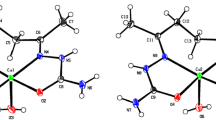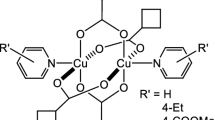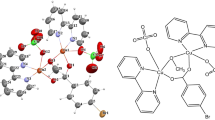Abstract
Treatment of a CuSO4 · 5H2O solution with NH2OH · HCl and NaOH produces orange–yellow Cu2O, which on being reacted with Ph3P and aqueous HF (48%) in MeOH or EtOH yields CuF(PPh3)3 · 2ROH (R = Me or Et) in high yield. The volatile compounds have been characterised by spectroscopic techniques in addition to chemical analyses and solution electrical conductance measurements. Typically, CuF(PPh3)3 · 2MeOH appears to be stable up to 118 °C and loses 2 MeOH and 3 PPh3 between 118 and 274 °C yielding volatile ‘CuF’ at 274 °C.
Similar content being viewed by others
References
T.G. Spiro (Ed.), Copper Proteins, Wiley International, New York, 1981.
R. Lontie, Copper Proteins and Copper Enzymes, Vol. I & II, CRC Press, Boca Raton, FL, 1984.
K.D. Karlin and J. Zubieta (Ed.), Copper Coordination Chemistry: Biochemical and Inorganic Perspectives, Adenine Press, New York, 1986.
K.D. Karlin and J. Zubieta (Ed.), Biological and Inorganic Copper Chemistry, Adenine Press, New York, 1986.
H. Gampp and A.D. Zuberbuhler, Chimia, 32, 54 (1978).
A.E. Martell, Pure. Appl. Chem., 55, 25 (1983).
T.G. Spiro, Metal Activation of Dioxygen, Wiley Interscience, New York, 1980.
S. Sakaki, G. Kogoa and K. Ohkubo, Inorg. Chem., 25, 2330 (1986).
A. Edel, P.A. Marnst and J.P. Sauvage, Nouv. J. Chem., 8, 495 (1984).
D.R. McMillin, J.R. Kircho. and K.V. Goodwin, Coord. Chem. Rev., 64, 83 (1985).
R.D. Reiki, D.E. Stack and B.T. Dawson, J. Org. Chem., 58, 2483 (1993).
W. Mijs and C. de Jonge, Organic Synthesis by Metal Compounds, Plenum, New York, 8423, 1986.
B.H. Lipshutz and S. Sengupta, Org. React., 41, 135 (1992).
T. Tsuda, T. Hashimoto and T. Saegusa, J. Am. Chem. Soc., 94, 658 (1972).
M.E. Gross, J. Electrochem. Soc., 138, 2422 (1991).
T. Khodas and M. Hampden-Smith, The Chemistry of Metals CVD, VCH, Weinheim, 1994.
P.M. Jeffries, L.H. Dubois and G.S. Girolami, Chem. Mater., 4, 1169 (1992).
D.J. Gulliver, W. Levason and M. Webster, Inorg. Chim. Acta, 52, 153 (1981).
F.H. Jardine, L. Rule and A.G. Vohra, J. Chem. Soc. (A), 238 (1970).
M.K. Chaudhuri, S.K. Chettri, P.C. Paul and P. Srinivas, J. Fluorine Chem., 78, 131 (1996).
B.R. Teo and D.M. Barnes, Inorg. Nucl. Chem. Lett., 12, 681 (1975).
G. Costa, E. Reisenhofer and L. Stefani, J. Inorg. Nucl. Chem., 27, 2581 (1965).
Author information
Authors and Affiliations
Rights and permissions
About this article
Cite this article
Chaudhuri, M.K., Dhar, S.S. & Vijayashree, N. Molecular complexes of copper(I): Easy access to CuF(PPh3)3 · 2ROH (R = Me or Et). Transition Metal Chemistry 25, 559–561 (2000). https://doi.org/10.1023/A:1007050908874
Issue Date:
DOI: https://doi.org/10.1023/A:1007050908874




